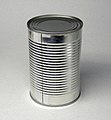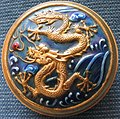Can
A jar (from Central Dutch dose for 'container for carrying', 'ark', ' suitcase '; documented in Germany since the 17th century) is originally a small, mostly square, round or oval container with a lid. Up until the 19th century, cans were richly decorated luxury items that were given in the form of portrait cans as pomp and honor gifts. They were used, if they were not just exhibits, to store particularly valuable goods - e. B. as a sugar bowl , Konfektdose ( candy dish ), Schmuckdose , snuffbox ( snuffbox ) or as a money box . Can clocks and music boxes were created as particularly luxurious versions with surprising contents . Boxes were handcrafted from materials such as precious metal , alabaster and porcelain and decorated with inlays made of ivory , mother-of-pearl , tortoiseshell , amber or enamel . Simple cans are made of sheet metal ( tin can ) or are made of different materials ( composite can ).
The original box later gave its name to numerous variants, which only partially have to do with its earlier use as a valuable storage container. Since the early 19th century, the term "can" is increasingly the tin associated since the 1930s with the derived from its beverage can .




